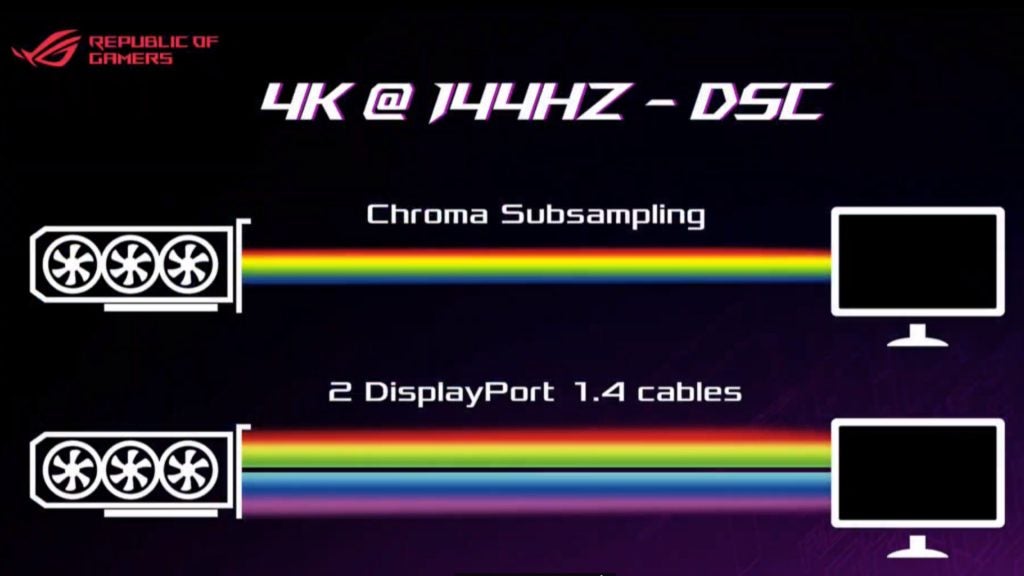Asus’s latest gaming monitors boast a 4K-ing brilliant party trick

Asus’s upcoming ROG Strix XG43UQ and ROG Strix XG27UQ gaming monitors promise to deliver smooth and scintillating 4K at up to 144Hz without you having to enable chroma subsampling, which removes colour data and can result in blurry images.
The new 43-inch Strix XG43UQ, announced at Gamescom 2019, sounds especially good. This one promises to support variable refresh rate technology – specifically, AMD Radeon FreeSync 2 – and claims VESA DisplayHDR 1000 certification, which means it’ll hit peak brightness of 1000 nits, consistently kick out 600 nits of brightness, and deliver 0.1 nit black level. Put simply, gaming on this ought to be a best-in-class experience.
The smaller 27-inch ROG Strix XG27UQ on the other hand promises 4K at up to 144Hz, and meets the requirements for the lower DisplayHDR 400 certification, which promises peak brightness of over 400 nits and consistent brightness of over 320 nits, so it won’t be as powerful.
Related: Best Gaming Monitor
That said, Asus claims that both the XG27UQ and the XG43UQ will cover 90% of the DCI-P3 colour space, which means that colours ought to look rich and realistic on both monitors and, in a pinch, these could be suitable for video editing work as well as gaming.
The main thing to focus on here though is support for Display Stream Compression (DSC), the video codec which allows for 4K at 144Hz to be streamed through one DisplayPort 1.4 connection with no apparent drop in quality.
Why is this a big deal? The current DisplayPort 1.4 standard gives you just enough bandwidth to handle 4K video at 120Hz. If you want more than this – because, say, you’ve just bought an Nvidia RTX 2080 Ti, and your gaming rig is powerful enough to do 4K at 144Hz – then your options are limited to a couple of things.

At Asus’s Gamescom launch event, technical marketing manager Steven Funcke briefly talked through relying on chroma subsampling, or using two DisplayPort 1.4 connections, and why neither of these solutions are desirable:
“[Consumers] want 4K and they want it at fast refresh rates. And that’s really hard to do. We’re currently already hitting the bandwidth limitation of DisplayPort 1.4…
“We use chroma subsampling, and we think it’s OK in certain situations. If you’re watching a movie, chroma subsampling’s fine, you probably won’t notice the bit of colour data that we’ve pulled out of that data stream. But, if you’re playing a game that has a lot of [head-up display elements], a lot of user-interface elements in front of the action, it’s not going to look great…
“The other thing that we’ve seen on the market, is you can actually just use two DisplayPort 1.4 cables and plug them both in… this is not really fun to set up in terms of the drivers, and you also lose the ability to have HDR, and you also lose the ability to have variable refresh rate technology, so FreeSync and G-Sync, both of them are out the window. Not a great solution if you want a premium experience with your display.”
During Asus’s Gamescom event, Funcke likened DSC support to zipping and unzipping files, with no loss of data at either end. While Funcke said that there’s no practical drawback to DSC, he did admit that this is something of a workaround that will do while the world waits for the DisplayPort 2.0 standard, which, amongst other things, should give us enough bandwidth for 16K video at 60Hz.
While prices and release dates for these new 4K Asus monitors haven’t been announced just yet, it goes without saying that your credit card is going to need a lot of bandwidth too – the Asus PG27UQ which we reviewed last year costs something in the region of £2000-£2500. Best start saving and hope that the economy doesn’t contract too much between the 31st of October and whenever these beasts go on sale.


